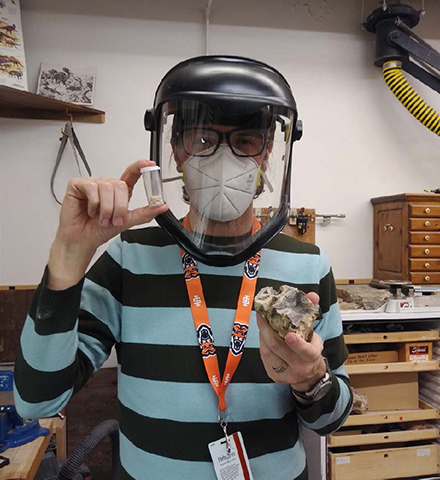Ancient DNA Research Upends Thinking on New Mastodon Species

January 10, 2024
Work by Museum paleontologists on fossil bones found at American Falls Reservoir are providing more insight into where and which one of North America’s largest-ever land animals was thousands of years ago.
“Back in 2019, some researchers established a new species of mastodon, the Pacific mastodon, using specimens from American Falls to help lay out the claim that the Pacific mastodon ranged from California to here in Southeast Idaho,” said Brandon Peecook, Assistant Curator of Vertebrate Paleontology at the Museum.
“Their assertion was based on mastodon teeth. We've been able to get DNA out of Idaho Ice Age fossils so we thought we'd see whether the DNA supports the idea of two species of mastodon. So far, the answer is: no.”
So, how do you unravel where a long-extinct species called home? The bones, of course. But not just by looking at the fossilized mastodon remains; Peecook and his fellow researchers had to get inside these bones. Peecook cored fossil teeth to gather up between 200 and 500 milligrams - about the size of two pills of over-the-counter ibuprofen - of material from two mastodon teeth found at American Falls Reservoir in the Museum's collections.
"It's been a complete surprise these last few years to discover that Idaho's Ice Age megafauna have such incredibly preserved genetic material in their teeth and bones. It's an open question why, how and even if the Snake River sands and muds helped somehow in this rare preservation."
Once they had their samples, they shipped them to the McMaster Ancient DNA Centre at McMaster University in Hamilton, Ontario for processing. It’s there where the DNA was extracted from the ~100,000-year-old fossils and compared to all the other complete American mastodon sequences.
"American mastodons were one of the first animals EVER to be recognized as extinct by western science, back in the late 1700s. So it's a big deal to think there is another possible species out west. Our results however show that the Idaho mastodons all belong in the American mastodon genetic lineage, and aren't their own separate "Pacific" lineage."
But which species wasn’t the only secret revealed by the DNA. The sequences also yielded some insight into these mastodon’s family tree.
"It was delightful to see hard evidence that the mastodons living in Idaho were in fact close relatives of mastodons living up in Alaska and the land bridge with Asia, as opposed to other mastodons from around the continent. It seems like Idaho's mastodons were part of a population that followed the ebb and flow of the giant ice sheets that came and went many times during the Pleistocene. To even be able to know things like that was unthinkable just a few years ago."
Emil Karpinski, Chris Widga, Andrew R. Boehm, Brandon R. Peecook, Melanie Kuch, Tyler J. Murchie, Hendrik N. Poinar, Mastodon mitochondrial genomes from American falls, Idaho, Quaternary International, Volume 668, 2023, Pages 1-6, ISSN 1040-6182, https://doi.org/10.1016/j.quaint.2023.06.006.
